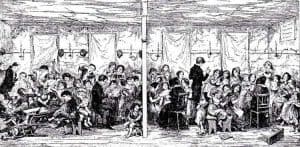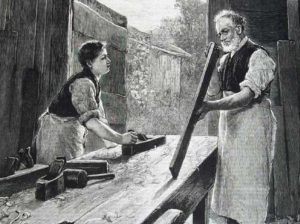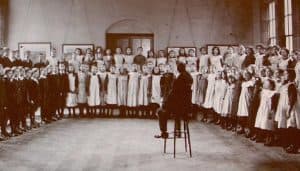Hello my dearest fellow Regency/Victorian fanatics! Today I want to talk to you about the least favorite topic of my children…school! Well, let’s be honest with each other, no child was ever crazy about going to school…And I am guilty as charged! Recess was always my favorite time of the day! But have you ever wondered how schools were like back in the day? I mean, we all know that the children of wealthy Lords and Ladies received their private lessons at home and did what they liked to the unfortunate governesses that struggled to teach the little rascals!But the working class children were mostly illiterate and, from what period films have taught us, misused by all “charitable” institutions. However, in a time that technology and industry were progressing faster than ever, literacy was essential for everyone. And this marked the foundation of a series of institutions that aimed to educate as many people as possible. And most of them would make teachers, parents and students shudder…! Let’s take a closer look!
Ragged Schools

Let’s start with Ragged schools! What a name though…They originated in the Sunday School founded in 1780 by Robert Raikes in Gloucester, who taught children to read so that they could read the Bible. Then a Portsmouth cobbler, John Pounds, gathered groups of children to play with his disabled nephew, and by 1818, had a class of 30 or 40!The idea spread to London. In 1844, 19 Ragged Schools joined to form a Ragged School Union and by 1861 they were teaching over 40,000 children in London, including the children of convicts, drunks and abusive step‐parents, and deserted orphans. Meanwhile Quintin Hogg, the son of a prosperous London merchant, had set up a Ragged School in 1863, when he was just 18. The London Polytechnic, now the University of Westminster, can trace its origin to Quintin Hogg. Well, okay, apparently no qualifications were needed to found your own school… At least they educated the poor children though!
Apprentices

While I wouldn’t dare imagine my son working at 10 years old, the idea of apprenticeships was admirable then. For a fixed term, usually seven years, a master of a trade would train a child so that he could earn his living at that trade. The norm was that they wouldn’t get paid, just eating and living with the master was enough. Prosperous merchants, goldsmiths and bankers made tidy sums from the premiums paid by the parents of hopeful apprentices. Poor masters could profit from the unpaid labour of children taken from the parish workhouse. There were many scandals of parish apprentices being so ill‐treated that they ran away, or even died. Oh my, stay in school kids!
Parish Schools
And this brings us to Parish workhouses. They were supposed to provide education for the children in their care, whom they had not managed to apprentice out, but this duty was poorly observed. Some satisfied it by shunting their children to the Central London District School for Pauper Children on the outskirts of London, known as the ‘Monster School’ because of its size – it housed 1,000 pupils. (Even Charlie Chaplin was one of them, later!)
Church Schools
The Church of England provided elementary education that adopted the Lancaster system whereby the brightest pupil taught what he had learned. Joseph Lancaster himself gave 1000 children some grasp of the rudiments, reading, writing and ‘reckoning’, in this way. The system was replaced by properly trained pupil‐teachers in 1846. Both establishments set up teacher training colleges, which gave their graduates the entrance to employment as well‐trained, certificated teachers.
The Jews Free School

The Jews Free School had opened in the east end of London in 1817. By 1822 it offered ‘a religious, moral and useful education’ to 600 Jewish boys and half as many girls – already almost up to the Monster School level. By 1870 it had 2,400 pupils, and was perhaps the largest school in the world. (It still exists today in Harrow!)
Education for Girls
Oh, all the above mostly referred to boys and men…What about the education of girls? In the upper classes it was assumed that a girl would marry and that therefore she had no need of a formal education, as long as she could look beautiful, entertain her husband’s guests, and produce a reasonable number of children. As if that wasn’t too much to ask already, but anyway…‘Accomplishments’ such as playing the piano, singing and flower‐arranging were all‐important. If she could not find a husband she faced a grim future as a ‘maiden aunt’ whose help could always be called on to look after her aged parents or her siblings’ children. But their future was improved when Queen’s College in London was founded in 1848. Ten more years saw the foundation of Cheltenham Ladies’ College and other girls’ public schools followed. This increase in female education led to renewed demands for the vote that were hotly denounced by the Queen, who from her position of unimaginable power saw no reason why women should want to vote at all. Well, can someone explain this to the lady? 😛
The Universities

And what about the ones that decided to stay in school for longer? For centuries, the ancient universities of Oxford and Cambridge had imposed three barriers to entrance. An applicant had to be 1: male; 2: unmarried; and 3: a member of the Church of England. While 2 and 3 could be evaded with a little cunning and I would add, wealth, 1 could not. Non‐sectarian colleges had been opened in London from 1828 onwards, grouped into London University in 1836. In 1878 London University admitted women to two colleges, Bedford College, and the Royal Holloway College. But Oxford and Cambridge held out against women until like the 50s! Well, this actually made me appreciate my privilege to access higher education as a woman. Now I only wish that reading this to my children will change their minds! What if I tell them that I’ll send them as apprentices instead? Haha!Did this make you appreciate modern day schools and education? Let me know!
Written byViolet Hamers!
Source: Education in Victorian England

 Share this book
Share this book